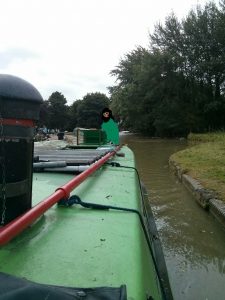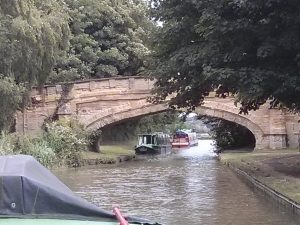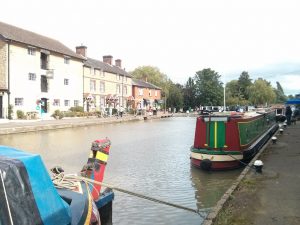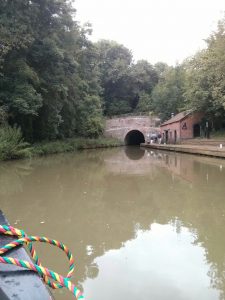Moving: trauma or ecstacy?!
Moving your new boat for the first time, seems, from my limited research, to often be stressful. The new boat owners I have met had boat-moving stories of battery failures, overheating, and struggling with the general vagaries of their new purchase. One couple had blown the entire boat electrics. Others hadn’t realised how much concentration moving a boat would take. For many of us there is a time constraint on getting the boat from old mooring to new. As the mooring fees expire in one marina it is necessary to get the boat to the paid for new mooring. Also, for newbie boat folk, just recognising that canals are a slow moving world is a huge shift from our usual, fast car-centred lives.
Willy Nilly and I approached the task with excitement and trepidation, knowing we had 3 days/2 nights to move the boat 39 miles from Cosgrove to Welford in August 2016. We had set the bar low and our motto for the entire trip was ensuring that ‘no-one dies’.

Lock crossing trauma
Having left Willy’s car at Welford we headed to Cosgrove. Once there we clambered across the lock to get to the boat. I see this lock at Cosgrove marina as the equivalent of having a medieval drawbridge around your castle. The novelty of crossing the lock to reach the boat had worn off in the preceding days as I had hauled bags of rubbish across the lock to the skips. This lock has no handy footbridge (unlike Welford), instead you walk across the top of the lock gates. For someone as clumsy as me, with a fear of heights, the entire process felt like the beginning of an episode of Casualty. That bit where they set the scene of a normal day, and you just know one of those characters will die, in a prolonged and agonising way! Even now I find locks frightening places and can trace this back to a 1970s public information film showing the danger of canals. The film ended with a coat being sucked down into dirty canal water and shots of the grim-reaper. (Clearly this should be seen in context of a 70s childhood growing-up in an era of spangles, Bagpuss and white dog poo!)
Goodbye to Cosgrove

It took us two hours to begin moving from Cosgrove. We said goodbye to the boat’s neighbours, negotiated out of the mooring, and re-moored for water. We then waited an hour as another boat filled up. At this rate we were not going to make Welford in 3 weeks, let alone 3 days… Finally, having filled the water tank we were moving. We passed under Cosgrove’s beautiful sandstone bridge and felt like we were making progress. Within another hour or so (it all blurs in ‘canal time’) the over-excited frenzy ebbed away as we moored at the bottom of Stoke Bruerne locks. I could clearly hear The Imperial March from Star Wars playing as we waited hopefully for an unsuspecting boat to share our first lock experience.
Stoke Bruerne locks
We were exceptionally lucky that a boat arrived crewed by experienced boaters from Nottingham. (The luck was their experience, rather than being from Nottingham, delightful though the city is.) The couple happily shared knowledge and tips with us, without raising an eyebrow at our total incompetence. We were also lucky to start moving through Stoke Bruerne locks at the bottom, without any gongoozlers watching our every move. (Gongoozler is the name given to those who stand -usually with arms folded- ogling canal boats, whether they be moored up or moving.) By the time we reached the village at the top of the 7 locks we felt able to fool the watching hordes into believing we were semi-pros. Relived to be over the first hurdle we said goodbye to our co-lockers and moored up at Stoke Bruerne. A chance to give the boat’s little 1 cylinder 1973 Sabb engine a rest whilst we had a wander.
Stoke Bruerne canal village

The Grand Union canal cuts the village of Stoke Bruerne in half. I can’t help but wonder (in my historian way) how the small village coped in the late 18th/ early 19th Century[1] with the arrival of 100s if not 1000s of men digging the canal and the Blisworth tunnel. Not to mention the villagers’ trauma of having a waterway traversing the centre of the village. Little wonder the canals are referred to as ‘the cut’. They physically and mentally cut places in half. Today, tourism at Stoke Bruerne focuses on the canal with boat trips and a Canal Museum, as well as festivals that take place during the year. We didn’t hang around long, but did have a chance to look at the remains of a disused dock and dropped into the Museum shop. We were too aware that our first tunnel experience loomed dark and long just outside of Stoke Bruerne – cue The Imperial March again…
Into the Blisworth tunnel

Blisworth Tunnel opened in 1805, and today is the 3rd longest navigable in the UK canal system. During its construction 14 men died. Once finished horse-drawn boats had to be ‘legged’ through the tunnel as there is no tow path inside. Legging required men to lay on their backs on planks of wood that straddled the boat, they would then ‘walk’ along the tunnel walls or roof. In the process slowly moving the boat through the tunnel. I was grateful that we didn’t have to attempt this. Though, standing in the bow shining a torch on the wall was enough for me. We arrived at the entrance inadequately prepared, leading to a scramble to turn on internal lights, and pull on waterproof jackets. Finally, with Willy helming and me doing a good impression of a light-shining figurehead, albeit one hanging on for dear life, we entered the gaping, black tunnel entrance.
This first tunnel experience did not go well. Willy struggled to keep a line when boats came towards us. The lack of brakes meant trying to judge the speed, wall distance and distance from other boats in the gloom. At one point we were going too fast and hit another boat. It was a moment of horror for us. Apart from yelling sorry 100 times there was little we could do to show our remorse. The screaming occupants of the other boat did little to calm our nerves and definitely did not help our concentration. It was a mistake that we learnt from. Since then I have been through a number of tunnels alone. I don’t think I will ever be comfortable navigating them. I find the experience disorientating, damp and generally dark, and will always try to avoid busy times.
The end of day 1
We did make it out of the other end and breathed a sigh of relief. Somehow we had managed 7 locks and a tunnel within hours on our first day of moving. After 6 ½ hours we had almost reached Bugbrooke. As the light was beginning to fade we decided to call it a day. We moored in parallel to the West Coast Mainline with its tilting Pendolino trains speeding past. Luckily, we were both so exhausted that the trains had little impact on our sleep. After knocking back a bottle of red and eating we collapsed in a heap. Though I hadn’t quite anticipated being woken in the night to a potentially sinking boat….
[1] www.british-history.ac.uk/vch/northants/vol5/pp374-413
I thoroughly enjoyed reading this. I know I shouldn’t giggle but the horror of you hitting a boat in the tunnel did make me laugh somewhat ?
Sorry for the delay in replying! Need to work out how to turn on alerts :-). So glad it made you laugh, the whole thing was ridiculous farce and I can now look back and laugh 🙂
Kay, as a potential NB owner I thoroughly enjoy all the details. It enables me to picture myself in similar situations. Keep up the episodes & thank you for sharing.
Thanks Helen! I am sure you will be far better at it than I was 🙂
Is blisworth the one where the water runs down the airvents – onto your head, if steering? After weeks of 4mph I got onto a bus that did 35mph, and was terrified! Hurry and write the next blog as I want to know why you’re sinking…
Edie,
I didn’t realise you had been down the canals! Yes many of them have water running down the vents, I remember Blisworth as being particularly wet – but then that could just be a dark memory. Next post either later today or tomorrow 🙂 Hope you are well.
PS congrats on finding such a lovely place to moor! Sounds perfect.
Yep, Welford is great for me, I didn’t quite realise it at the time, but it was the perfect choice.